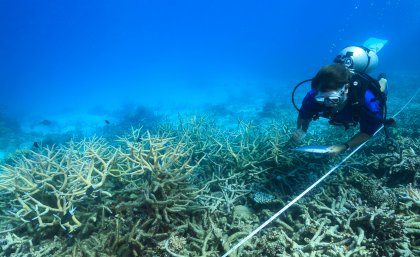
University of Queensland researchers are part of a team that will conduct Great Barrier Reef aerial and underwater surveys this month as coral bleaching occurs for the second year in a row.
The work coincides with a report in the journal Nature today, which says the reef’s resilience is waning rapidly.
UQ School of Biological Sciences researcher Professor John Pandolfi said scientists from UQ and other institutions would compare the extent of coral bleaching damage that had occurred this summer with that of last summer.
Professor Pandolfi is one of 46 researchers who contributed to the Nature report.
He said coral bleaching events should not be seen as individual disturbances to reefs, but as recurring events that threatened the viability of coral reefs globally.
“We have known for some time that ‘refuge’ areas nearby help reef coral rebound after a bleaching event, but last year’s bleaching has shown that unfortunately this ability breaks down as bleaching becomes more severe,” Professor Pandolfi said.
The newly published research was led by ARC Centre of Excellence for Coral Reef Studies Director Professor Terry Hughes, at James Cook University.
Professor Hughes said the research team hoped temperatures would drop quickly in the next two to three weeks, and this year’s bleaching would not be as severe as in 2016.
“The severity of the 2016 bleaching was off the chart,” he said.
“It was the third major bleaching to affect the Great Barrier Reef, following earlier heatwaves in 1998 and 2002. Now we’re gearing up to study a potential number-four.”
The research found that in 2016 catastrophic levels of bleaching occurred in the northern third of the reef, a region about 800km long.
Professor Pandolfi said coral bleaching occurred when abnormal environmental conditions such as high sea temperatures caused corals to expel tiny photosynthetic zooxanthellae algae.
“The loss of these colourful algae causes the corals to turn white,” he said.
“Bleached corals can recover if the temperature drops and zooxanthellae are able to recolonise them. Otherwise the coral may die.”
Professor Pandolfi said anyone who observed coral bleaching on the reef should report it to the Great Barrier Reef Marine Park Authority at eyeonthereef@gbrmpa.gov.au.
Media: Professor John Pandolfi, j.pandolfi@uq.edu.au, +61 (0)7 3365 3050, +61 (0)400 982 301; Professor Terry Hughes, Terry.Hughes@jcu.edu.au, +61 (0)400 720164, +61 (0)7 4781 4000.
.jpg)












